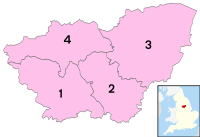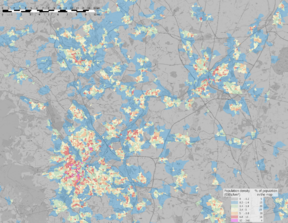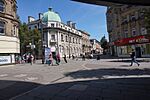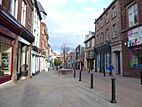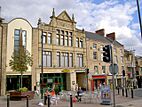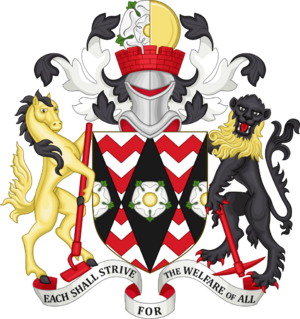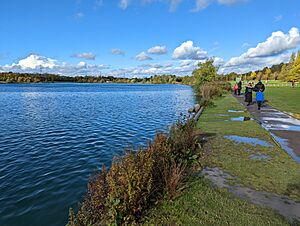South Yorkshire facts for kids
Quick facts for kids
South Yorkshire
|
|||||||||||||||||||||||||||||||||||||||||
|---|---|---|---|---|---|---|---|---|---|---|---|---|---|---|---|---|---|---|---|---|---|---|---|---|---|---|---|---|---|---|---|---|---|---|---|---|---|---|---|---|---|
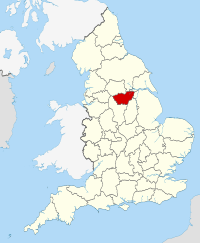 |
|||||||||||||||||||||||||||||||||||||||||
| Sovereign state | United Kingdom | ||||||||||||||||||||||||||||||||||||||||
| Constituent country | England | ||||||||||||||||||||||||||||||||||||||||
| Region | Yorkshire and the Humber | ||||||||||||||||||||||||||||||||||||||||
| Established | 1 April 1974 | ||||||||||||||||||||||||||||||||||||||||
| Established by | Local Government Act 1972 | ||||||||||||||||||||||||||||||||||||||||
| Time zone | UTC±00:00 (Greenwich Mean Time) | ||||||||||||||||||||||||||||||||||||||||
| • Summer (DST) | UTC+01:00 (British Summer Time) | ||||||||||||||||||||||||||||||||||||||||
| Members of Parliament | List of MPs | ||||||||||||||||||||||||||||||||||||||||
| Police | South Yorkshire Police | ||||||||||||||||||||||||||||||||||||||||
|
|||||||||||||||||||||||||||||||||||||||||
South Yorkshire is a special county in England. It is part of the Yorkshire and the Humber region. It shares borders with North Yorkshire and West Yorkshire to the north. To the northeast is the East Riding of Yorkshire. Lincolnshire is to the east, and Nottinghamshire to the southeast. Derbyshire is to the south and west. The biggest city in South Yorkshire is Sheffield.
Most of the county is made up of towns and cities. It covers about 1,552 square kilometers (599 square miles). Around 1.4 million people live here. After Sheffield (with 556,500 people), the largest places are Doncaster (113,566), Rotherham (109,697), and Barnsley (96,888). The eastern and western parts of the county are more rural. South Yorkshire is managed by four main areas called metropolitan boroughs. These are Barnsley, Doncaster, Rotherham, and Sheffield. They work together through the South Yorkshire Mayoral Combined Authority.
South Yorkshire is located near the Pennines mountain range. The western part of the county includes some of the Peak District National Park. The River Don starts in these hills. It flows through Sheffield, Rotherham, and Doncaster. Then it reaches the flat Humberhead Levels in the east.
Contents
History of South Yorkshire
The county of South Yorkshire was officially created in 1974. But the towns and areas within it have histories going back many centuries.
Ancient Times
People have lived in this area for a very long time.
- Archaeologists found a Stone Age "house" near Deepcar, Sheffield. It's a circle of stones shaped like a hut base. This house is about 10,000 years old (8000 BC).
- Even older signs of people exist nearby at Creswell Crags in Derbyshire. Here, tools and cave art have been found. They are at least 12,800 years old.
- During the Roman Empire period, this region was on the edge of Roman lands.
Industrial Growth
The main towns in South Yorkshire grew because of two big industries:
- Mining: Coal was mined mostly in the north and east of the county. Iron was also found and mined here.
- Steel: The rivers flowing from the Pennines in the west helped power the steel industry. This industry was strong in Sheffield, Stocksbridge, and Rotherham. Having iron and coal nearby made it a perfect place for making steel.
Local Government Changes
In 1969, a report called the Redcliffe-Maud Report suggested big changes to local government. It said that separating towns and rural areas was old-fashioned. It noted that towns provided jobs and services for people in the countryside. Also, townspeople used the countryside for fun.
The idea of a metropolitan county like South Yorkshire was part of these plans.
| After 1974 | Before 1974 | ||||
|---|---|---|---|---|---|
| Metropolitan county | Metropolitan borough | County boroughs | Non-county boroughs | Urban districts | Rural districts |
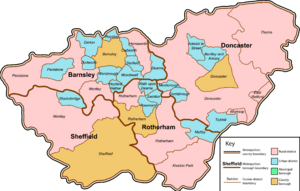 |
Barnsley | Barnsley | – | Cudworth • Darfield • Darton • Dearne • Dodworth • Hoyland Nether • Penistone • Royston • Wombwell • Worsbrough | Hemsworth • Penistone • Wortley (part) |
| Doncaster | Doncaster | – | Adwick le Street • Bentley with Arksey • Conisbrough • Mexborough • Tickhill | Doncaster • East Retford (part) • Thorne • Worksop (part) | |
| Rotherham | Rotherham | – | Maltby • Swinton • Rawmarsh • Wath upon Dearne | Kiveton Park • Rotherham | |
| Sheffield | Sheffield | – | Stocksbridge | Wortley (part) | |
South Yorkshire Today
The Local Government Act 1972 officially created South Yorkshire on April 1, 1974. The South Yorkshire County Council (SYCC) started running in 1973. This new system aimed to balance local loyalty with modern planning needs.
At first, South Yorkshire had two levels of local government. There was the county council for big plans. Then there were four districts that provided most services.
In 1986, county councils like SYCC were removed across England. Their jobs were given to the local boroughs. Some services, like fire, police, and public transport, are now managed by joint boards. The South Yorkshire Passenger Transport Executive and the South Yorkshire Police and Crime Commissioner are examples of these.
Even though the county council was abolished, South Yorkshire is still a metropolitan and ceremonial county. It has a Lord Lieutenant of South Yorkshire and a High Sheriff. These are important local roles.
South Yorkshire is also part of the Sheffield City Region. Barnsley is also linked to the Leeds City Region. This shows its location between Yorkshire's two biggest cities.
Geography and Landscape
South Yorkshire shares borders with six other counties. These are Derbyshire, West Yorkshire, North Yorkshire, East Riding of Yorkshire, Lincolnshire, and Nottinghamshire.
Land Features
The county's landscape is shaped by the Pennines mountains. These hills rise in the west and gently slope down to the Humberhead Levels in the east.
- The geology is mostly carboniferous rocks from the Yorkshire coalfield. This creates a landscape of rolling hills, steep slopes, and wide valleys.
- You can see many signs of past and present industry here. There are old mine buildings, spoil heaps, and steel plants.
- The scenery is a mix of towns, industrial areas, and open farmland. Roads and canals often have buildings along them. But some natural areas and older landscapes still remain.
Western Moors and Valleys
The Pennines in the west are mostly within the Peak District National Park.
- The rocks here are mainly millstone grit sandstones. This area is known as the Dark Peak. It has moorland plateaus and gritstone edges.
- Between the Dark Peak and the coalfield, there are many steep valleys. The landscape changes from uplands and rural areas to lower, urban areas as you go east.
- Important rivers like the Dearne, Rother, and Don flow through this area.
- Further east, near Doncaster, the land becomes flatter. This is where the coalfield rocks are covered by deposits from the Humberhead Levels.
Green Belt Areas
South Yorkshire has a green belt around its four districts. This green belt was first planned in the 1950s. It helps to protect natural spaces and stop towns from spreading too much. The western edge of Sheffield and Barnsley districts directly touches the Peak District National Park boundary.
Towns and Cities
The table below shows many of the towns and villages in South Yorkshire. They are grouped by their main metropolitan borough.
| Metropolitan county | Metropolitan borough | Centre of administration | Other places | |
|---|---|---|---|---|
| South Yorkshire | Barnsley (borough) | Barnsley (town) | Billingley, Birdwell, Bolton-upon-Dearne, Cudworth, Darfield, Darton, Dodworth, Goldthorpe, Great Houghton, Grimethorpe, Hoyland Nether, Royston, Penistone, Thurnscoe, Wombwell, Worsbrough | |
| City of Doncaster | Doncaster (city) | Adwick le Street, Armthorpe, Askern, Auckley, Balby, Barnby Dun, Bawtry, Bentley, Bessacarr, Braithwell, Branton, Cantley, Carcroft, Conisbrough, Cusworth Denaby, Dunscroft, Dunsville, Edenthorpe, Edlington, Finningley, Fishlake, Hatfield, Hyde Park, Intake, Kirk Sandall, Loversall, Marr, Mexborough, Micklebring, Moorends, Scawsby, Scawthorpe, Skellow, Stainforth, Rossington, Sykehouse, Norton, Thorne, Tickhill, Wadworth, Warmsworth, Wheatley, Wheatley Hills | ||
| Rotherham (borough) | Rotherham (town) | Anston, Aughton, Brinsworth, Dinnington, Harthill, Kiveton Park, Maltby, Rawmarsh, Scholes, Swinton, Thorpe Hesley, Todwick, Treeton, Thurcroft, Wales, Wath-upon-Dearne, Woodsetts, Whiston | ||
| City of Sheffield | Sheffield City Centre | Beighton, Chapeltown, Highlane, Mosborough, Oughtibridge, Stocksbridge, Wharncliffe Side | ||
South Yorkshire has three main urban areas:
- The Dearne Valley area, which includes Barnsley and its surrounding towns.
- The Sheffield urban area, covering Sheffield, Rotherham, and nearby places.
- The Doncaster urban area, which includes Doncaster and its surrounding towns.
How South Yorkshire is Governed
South Yorkshire is governed by four main councils. These are the City of Sheffield, the City of Doncaster, the Metropolitan Borough of Barnsley, and the Metropolitan Borough of Rotherham.
In 1986, the South Yorkshire County Council was abolished. Its jobs were passed down to the individual boroughs. Many services are now managed by joint authorities. These groups include representatives from all four councils. For example, public transport is managed this way.
The South Yorkshire Mayoral Combined Authority was set up in 2014. It brings together the leaders of the four councils. This group helps to make big decisions for the whole county. It is led by the Mayor of South Yorkshire, who is elected by the public.
In the 2016 vote on whether the United Kingdom should stay in the European Union, South Yorkshire voted to leave. About 62% of people voted to leave, and 38% voted to remain.
| Body | Headquarters | Notes |
|---|---|---|
| South Yorkshire Mayoral Combined Authority | Castlegate Quarter, Sheffield City Centre | Formerly Sheffield City Region Combined Authority, includes South Yorkshire Passenger Transport Executive |
| South Yorkshire County Council | Central Offices, Barnsley | Abolished in 1986 |
| South Yorkshire Joint Secretariat | Barnsley | The only metropolitan county in the UK that has established a formal joint secretariat. |
| South Yorkshire Fire and Rescue Service | Cultural Industries Quarter, Sheffield City Centre | |
| South Yorkshire Police | Carbrook, Sheffield | |
| Barnsley Metropolitan Borough Council | Barnsley Town Hall | Covers Metropolitan Borough of Barnsley |
| Doncaster Council | Doncaster Civic Office | Covers City of Doncaster district |
| Rotherham Metropolitan Borough Council | Rotherham Town Hall | Covers Metropolitan Borough of Rotherham |
| Sheffield City Council | Sheffield Town Hall | Covers City of Sheffield district |
Economy and Jobs
South Yorkshire has been a focus for funding from the European Regional Development Fund. This is because it was once one of the less wealthy areas in Western Europe.
However, the county's service industry has grown recently. In 2022/23, Doncaster was named the best small city in Europe for investment. This was in the FDI European Cities and Regions of the Future Awards.
The table below shows how much money (Gross Value Added) the region has produced over the years.
| Year | Regional Gross Value Added |
|---|---|
| 1998 | £12,820 |
| 2001 | £13,921 |
| 2004 | £17,718 |
| 2007 | £21,192 |
| 2010 | £21,512 |
| 2013 | £22,560 |
Places to Visit
| Key | |
| Owned by the National Trust | |
| Owned by English Heritage | |
| Owned by the Forestry Commission | |
| A Country Park | |
| An Accessible open space | |
| Museum (free) | |
| Museum (charges entry fee) | |
| Heritage railway | |
| Historic House | |
South Yorkshire has many interesting places to visit, including:
- Abbeydale Industrial Hamlet, Sheffield

- Brodsworth Hall and Gardens

- Cannon Hall Museum, Park & Gardens, Barnsley

- Chapel of Our Lady of Rotherham Bridge ("Chapel on the Bridge"), Rotherham
- Clifton Park Museum, Rotherham

- Conisbrough Castle

- Cusworth Hall

- Doncaster Minster
- Doncaster Mansion House
- Elsecar Steam Railway

- Howden Moors

- Kelham Island Museum, Sheffield

- Magna Science Adventure Centre
- Meadowhall Centre, Sheffield
- Monk Bretton Priory

- Pot House Hamlet
- Sheffield Winter Gardens

- Roche Abbey

- Rotherham Minster
- Rother Valley Country Park

- RSPB Old Moor Wetland Centre
- Sheffield Cathedral
- Ulley Reservoir & Country park

- Wentworth Castle & Gardens, Barnsley

- Wentworth Woodhouse

- Weston Park Museum & Mappin Art Gallery, Sheffield

- Woodlands model village
- Worsborough Mill and Country Park

- Wortley Top Forge
- Yorkshire Wildlife Park
See also
 In Spanish: Yorkshire del Sur para niños
In Spanish: Yorkshire del Sur para niños






